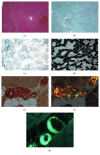A Rare Case of Systemic AL Amyloidosis with Muscle Involvement: A Misleading Diagnosis
- PMID: 29651353
- PMCID: PMC5831914
- DOI: 10.1155/2018/9840405
A Rare Case of Systemic AL Amyloidosis with Muscle Involvement: A Misleading Diagnosis
Abstract
Muscle involvement in AL amyloidosis is a rare condition, and the diagnosis of amyloid myopathy is often delayed and underdiagnosed. Amyloid myopathy may be the initial manifestation and may precede the diagnosis of systemic AL amyloidosis. Here, we report the case of a 73-year-old man who was referred to our center for a monoclonal gammopathy of undetermined significance (MGUS) diagnosed since 1999. He reported a progressive weakness of proximal muscles of the legs with onset six months previously. Muscle biopsy showed mild histopathology featuring alterations of nonspecific type with a mixed myopathic and neurogenic involvement, and the diagnostic turning point was the demonstration of characteristic green birefringence under cross-polarized light following Congo red staining of perimysial vessels. Transmission electron microscopy (TEM) confirmed amyloid fibrils around perimysial vessels associated with collagen fibrils. A stepwise approach to diagnosis and staging of this disorder is critical and involves confirmation of amyloid deposition, identification of the fibril type, assessment of underlying amyloidogenic disorder, and evaluation of the extent and severity of amyloidotic organ involvement.
Figures



References
Publication types
LinkOut - more resources
Full Text Sources
Other Literature Sources

